It was 1814, the Capitol in Washington was stormed. Then, the British not only stormed the Capitol but also burned down the White House.

One of the scenarios I predicted many blogs ago is that Trump would foment insurrection. I said he may set fire to the White House which, with two weeks of his gangster presidency – as one person has defined it – still leaves the metaphor to be converted to actuality. However, essentially Trump is a bully and thus by definition a coward. In his twisted mind, he wants the Biden Inauguration to be limited so that he can say he attracted a bigger crowd at his inauguration in 2017 as if that has any relevance to anything.
Trump predictably incited, and then the mob did what mobs do when they are allowed to act without adequate law enforcement. However, it could be argued that pictures of storming the Capitol, vandalising the Constitution in the name of this would-be despot, will galvanise the response of the lawmakers. The only saving grace was that Trump had not organised an armed militia to back his activities.
However, a cynical person would believe that an undermanned police force being overwhelmed initially provided the horror of this unbridled mob, whereas the optics of a massive law enforcement force beating up legitimate protesters may have provided unwarranted sympathy for the Trump “stormtroopers”.
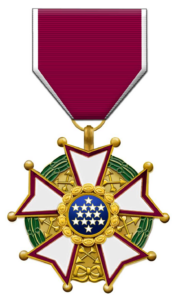 The award of the Legion of Merit should be returned by Morrison before it becomes his Millstone of Dishonour. I am sure the award will be noted by the incoming Biden administration, and as the charge sheet against Trump increases this year, comparisons between Morrison and the corruption which has flourished under his stewardship with his mentor, Trump should increasingly become front and centre of the political debate.
The award of the Legion of Merit should be returned by Morrison before it becomes his Millstone of Dishonour. I am sure the award will be noted by the incoming Biden administration, and as the charge sheet against Trump increases this year, comparisons between Morrison and the corruption which has flourished under his stewardship with his mentor, Trump should increasingly become front and centre of the political debate.
Yet a year ago, who would have thought that the Democrats would have won both the Senate seats in Georgia. Biden has confounded me by his Presidential response to the Trump rant. He has stepped up.
Who will stand up for Australia?
Giving In without a Kelp?
This first blog blot of 2021 was prompted by an article on seaweed in a recent December issue of the New York Review of Books (NYR). I start in a laneway of Helsinki. We had just emerged from a crowded bar, where although we had booked, we were subject to the Finnish way – the people in the sitting before us were lingering and we could wait, couldn’t we, until they had finished? It was not a particularly friendly interchange, the restaurant was noisy, the atmosphere had that scurry of youth, and persons of age were regarded as somewhat out of place and thus there was nowhere to sit – and nobody moved to give us room to sit down.
Hence, upsticks literally and off down the lane to the harbour. Here on a summer’s day when you can buy cloudberries it is beautiful place to saunter in the warm sunshine, along its quay where a multitude of colourful vessels of different configuration and size are moored. But now my days of sauntering are over. Using two sticks is a very inefficient way to saunter.
This day, on turning a corner, there was a restaurant. Given that it had begun to rain heavily, it was more haven than gastronomy which drove us to enter. Instead of a noisy crowd, there were tables set in a way which beckoned the discerning diner rather than us sodden accidental tourists.
The staff were solicitous as there were few if any other customers.
We looked at the menu as something to do, and one of the waiters told us there was fresh asparagus – new season white asparagus. This dish has stuck in my memory ever since. White asparagus do not have the robustness and stringiness of the green variety; there is a certain delicate taste to them, and the way they were presented in a light coat of butter was as though we were eating the first picked.
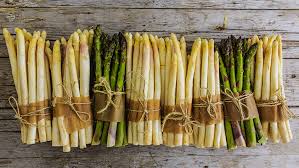
This year as the Australian green asparagus harvest appeared, I wondered whether white asparagus would be available. At the same time, I remembered it was the time sea asparagus was harvested. Sea asparagus or samphire was somewhat of a fad a few years ago and was available around November for a limited time. It had a vague resemblance to asparagus and like much of seashore plants harvested had a salty taste, while otherwise the taste was unremarkable except that it was different from asparagus.
It was told to me that if one went to Kooweerup in Victoria, the swampland home of the growling grass frog and southern bandicoot and also home for asparagus, would be where you would find the white variety. If one went along certain Victorian foreshores where samphire was said to grow in abundance, then my lust for this delicacy would have been satisfied. However, Victoria was a prison due to the Virus at harvest time for these two commodities. Nevertheless, this year I tried to obtain some. Being locked away in a different state leads one to yearn for that which proved, like the Holy Grail, to be unobtainable.
These are products where water is essential, but they exist very much on the edge of the western community palate. What about seaweed then?
When I buy sashimi, the accompaniment is wakame seaweed salad. The Japanese also use the black paper nori seaweed to wrap the sushi rice up with its various ingredients.
As for me, in the 1934 film “Man of Aran” that I wrote about earlier, the islanders grew potatoes in the bladderwrack, kelp left in the cracks of the stone in that harsh land. Then “When the potatoes failed, they survived on Chondrus crispus or Irish moss.” I once bought some carrageenan, a derivative from this red seaweed, back from Ireland. It hung around in the pantry with a ban put on it – the one which says: “if you want to cook it you can do it for yourself”. I succumbed to the blatant discrimination and eventually this vegan substitute for gelatin was thrown out unused.
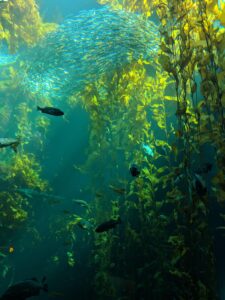
Then there are the magnificent kelp forests. One the most spectacular is the 8.5m high one at the Monterey Aquarium, which occupies three floors of this building in this Californian coastal town made famous by Steinbeck in his writing about Cannery Row.
In the article “The Oldest Forest” Lucy Jakub who, as one would expect lives on a beach, reviews four books where seaweed is the hero. One of these books lists all the products from sunscreen to fertiliser where kelp is used. In fact, the author, Ruth Kassenger, adopts “a speculative theory, that early man had a diet rich in iodine and docosahexaenoic acid (DHA) derived from algae through a number of secondary sources, which resulted in our larger brain”.
Seaweed in East Asia is a $6 billion a year bonanza, and its commercialisation was due to a British biologist Kathleen Drew-Baker, who showed in 1948 that the red seaweed, Porphyria, grew in two cycles – in the deep ocean releasing immature spores which settle closer to shore when right to propagate. (As a result of her work), Japanese scientists, in the midst of famine in US-occupied Japan, learned to pre-seed lines of nori in the lab and bring them to the ocean to grow.
Yet the article does not see any advocacy for further commercialisation. Attempts to propagate seaweed commercially as a substitute for fossil fuel in the USA have proved disastrous or viewed as Exxon’s investment as “greenwashing”. For instance, in the past decade, Exxon has spent $1.2 billion more on advertising than it has on biofuel development. After all, the Germans used seaweed as a source of potash, and the British for acetone for wartime use (WW1) when other materials were in short supply.
Yet growing seaweed is seductive as it is able to control the microblooms of the toxic algae by absorbing the fertiliser runoffs and moreover cattle fed seaweed produce less methane. However, among the experts quoted by the author, there is a consensus that where algae are grown commercially, it should be done so on small independent ocean farms. Overall, one writer Josie Iselin is quoted that we should: “leave the algae alone to do their own thing, heal the oceans as they can, and let them be, as the profound ecological engineers they are, not another for us to figure out how to manage.” After all, already “kelp forests naturally sequester 11% of their carbon in the sea”.
The NYR writer, Lucy Jakub is very perspicacious, because the prospect of worldwide famine is no longer an idle thought from a bunch of learned scientists gathering as the Club of Rome was in rediscovering Malthus. As she writes: crises lead to a search for silver bullets, in the hope they can be averted with unimaginable sacrifice, and in a spirit of optimism… (that can take) an algal-central perspective to envisioning the solution.
Just like the quest for white asparagus and samphire?
Life with the Bubble
Some years ago, I was in Brisbane staying in an upmarket hotel. I had just come in from a run along the Brisbane River. I came in, picked up a can of Diet Coke, ripped off the top and drank what would be considered a large gulp. Then, catastrophe. Let me say that it was the only time I have this intensely painful tearing sensation retrosternally. The intensity of the pain lives in my memory.
Cardiac pain has been described as a crushing pain in the same region, but one of the differential diagnoses is damage to the oesophagus mucosa, including oesophageal perforation. Perforation of the oesophagus is a potentially fatal condition as the pleural cavity and the mediastinum do not respond well to a flood of dilute hydrochloric acid or for that matter enzymic rich saliva and regurgitated gastric content.
After the acute pain, I was left with a dull pain. I rang a doctor friend, and before long I was in the intensive care unit of a major Brisbane hospital.
Fortunately, the chest Xray revealed that there was no perforation, and I was saved from a gastroscopy. The major discomfort and difficulty in swallowing meant fluids for a few days. After a few days, it settled down and I was discharged, wiser perhaps.
I had a “bit of form” as an acquaintance reminded me later when he showed me a photograph of me in a Barcelona restaurant pouring a porron of wine down my throat with the beginner’s luck in the amount of spillage being minimal.
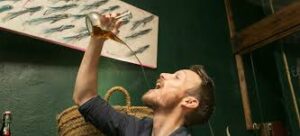
However, I had no such luck on this occasion.
As background, spontaneous oesophageal perforation was first described by the Dutch physician Hermann Boerhaave in 1724. Boerhaave’s syndrome is a form of barogenic rupture caused by a rapid rise in intraluminal pressure when there is sudden distension of the oesophagus in a closed space. The original case described was one of explosive vomiting.
Rapid ingestion of the cold beverage with bubbles can led to spasm of the distal oesophagus followed by expansion, resulting in a sudden build-up of intra-oesophageal pressure. The vast majority of perforations occur in the left lateral wall of the distal oesophagus, 3–6 cm above the gastro-oesophageal junction, as this part is particularly weak.
What prompted this reminiscence is the latest Coca-Cola advertisement where these jolly young things are shown irresponsibly attacking these beverages, with one complete numbskull leaning backwards and pouring the drink down her upside down throat where the forces of gravity mean the fluid has to flow uphill against them. Not like our famous Prime Minister with his imbibing a yard of beer where the beer could at least flow downhill, given presumably that Hawke, like all bright bored students, had spent time when learning this party trick to also learn how to control his oesophageal reflexes.
This particular appalling example in the obviously American advertisement was the young woman who needs to use her oesophagus musculature to ensure that the Coca Cola could flow uphill. She was obviously a performer, who had trained herself to do so. Perhaps, the whole scenario was fake, concocted. In the event of those who would dare to “copy-cat” this manoeuvre, will Coca-Cola assume responsibility for all the potential incidents that may happen?
Youth have no fear, youth will push the limits. Coca Cola is the driving force. That is always the message – derring-do with a bottle of Coke.
After all, who was the person when I was young who taught me how to open a bottle with my teeth.
Fortunately, St Paul had a message for me (sorry the political incorrectness) which I heeded through cracked teeth:
When I was a child, I spoke as a child, I understood as a child, I thought as a child; but when I became a man, I put away childish things.
Well, not completely. However, I do tend to learn from my mistakes.
Tea for Two
Ceylon is always associated with tea. Just after the start of World War 2
Great Britain purchased 80 per cent of the Ceylon and Indian tea crop. Australia was left out and tea was rationed here during the War. Tea plantations in Ceylon had been associated with Lipton but together north-east India (Assam and Darjeeling) with China being there the earliest Australian source. During the War, the Australian largely garrisoned Ceylon, because the local Ceylonese were not trusted. In fact, Ceylonese troops in the British Army rebelled on the Cocos Island wanting to surrender to the Japanese, with the result that after the rebellion was quelled, three of the rebels were executed, the only time during the War that British troops were executed for treason.
Then after the War, when your relatives went “Home to GB” by ship, the first port of call was always Colombo, the tell-tale memento being the carved ebony elephant on the mantelpiece.

The other attractions of Ceylon for a young eye were the stamps. These were large rectangles with the portrait of the sovereign in the upper right quadrant. They were informative because the plates had been so finely engraved. The commonest stamp of the set sent on mail was the 20c, with deep blue engraving of coconut palms bending in an unseen wind, but distant was a two-masted boat, presumably at anchor because the sails were furled. Several years ago, I bought the 11-stamp series, admittedly with King George V’s head in the corner. Each of the stamps features one idyllic scene which is far from the current situation in Sri Lanka. The stamps nevertheless illustrate the diversity that was Ceylon.
Until 2016, I had only visited Colombo airport en route from Singapore to London on Air Ceylon in 1971. The next year the name of Ceylon, derived from the old Portuguese name, was changed to Sri Lanka – “Resplendent Island”.
Sri Lanka had been a place where there were many religions. The Buddhist Sinhalese dominate the South, and at one time the Hindu Tamils were in control the north. Independence was accompanied by a debilitating war between the two populations, and in 2016 the tourist trail was well insulated.
There are many Ceylon burghers in Australia, those the results of miscegenation with the Dutch or Portuguese; they had been emigrating to Australia post-war. This was the closest coloured people were allowed as migrants from that country while the White Australia Policy was in force. They are predominantly Christian.
Then there were the Muslim Sri Lankans. I had involvement in counselling one, an international medical graduate who was both Muslim and a Sri Lankan national. I had not realised up to that time that Muslims form a significant minority in Sri Lanka. I found out that they control the gem trade.
The other association I have made with Ceylon was its sapphires. Those whose jewellery containing a Ceylon sapphire knew it to be so because of its intense blue. However, as a change on this trip I bought a green sapphire, together with an aquamarine. The choice in that emporium in Kandy seemed endless.
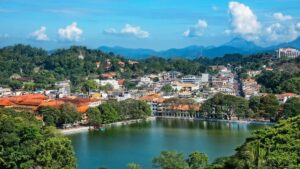
Driving to Kandy, the old capital and then driving to Galle could not be more different. They are both about the same distance from Colombo, but driving to the old Capital, Kandy was like driving along a ribbon shopping strip for 120 kilometres, without any break between the settlements for countryside. Beyond Kandy in the mountains are the terraced tea plantations where women were harvesting the leaves and placing them in a bag, the holding straps of which were firmly stabilised by the woman’s forehead. The technique is portrayed in the 9c pre-war stamp of a tea picker – a woman of course.
Galle, after a minor bottleneck in Colombo, is a four-lane drive away. Until they started playing test cricket there, I had never heard of it. Then the tsunami came on Sunday 26 December 2004 after the massive earthquake under the sea north of Sumatra.
In the words of one of Galle citizens who was watching at the time:
A long stretch of Sri Lanka’s coast was devastated by these killer waves, with more than 40,000 dead and staggering 2.5 million people displaced. Although 1,600km from the epicentre, the waves struck with huge force and swept inland as far as 5 kilometres. Waves as high as six meters had crashed into coastal villages, sweeping away people, cars and even a train with 1700 passengers.
One of the worst hit areas was my home city Galle, the capital of Southern Sri Lanka. The water came from two sides to Galle town giving no chance for many people who were going about their daily life…
This happened while civil war was being waged – a 25-year civil war between Tamil and Sinhalese that did not end until 2009. An estimated 80,000-100,000 people died between 1982 and 2009. The deaths include 28,000 Tamil fighters, more than 21,000 Sri Lankan soldiers, 1,000 Sri Lankan police, 1,500 Indian soldiers, and tens of thousands of civilians.
Here we were seven years later in a country that had papered over so much trauma in its community fabric, and we, the Australian visitors, were travelling around as though Sri Lanka was still the Pearl of the Orient. As our driver in Galle said, those who were within the walls of the old Dutch fortress had a far greater chance of survival when the tsunami came.
When we visited, Galle exhibited few scars and the cricket ground, where Shane Warne achieved his 500th Test wicket, looked as though nothing had happened, but then 12 years had passed before we visited.
However, one major reason to go existed beyond Galle when the road reverted to type and we travelled through seaside villages until there they were, the men stilt fishing, their bodies entwined on a pole with a cross bar several metres above the water and at the same time fishing. No fishing in waders or from a wharf. Fishing this way enables them not to disturb the water. The tsunami curtailed this form of fishing; the stilts have returned, but not to the same number.
So many recollections associated with this country, with all its various names suggesting serenity, yet so little has the community strife had an impact we could have been traveling on a magic carpet far away from all that horrendous backdrop. Life on our magic carpet seemed so welcoming and tranquil.
How far from the Truth?
As I written about the injustice meted out to them, the Tamil family, Priya Murugappan, her husband Nades, and their two Australian-born daughters – Kopika now aged five, and Tharunicaa aged three imprisoned on Christmas Island, do not think so, even though the Australian authorities seem to make sure that the horrors awaiting them are not lost in a welter of government generosity and kindness. They get none.
Unlike the time Minister Dutton laid a wreath on the altar of St Sebastian’s in Colombo in 2019. How touching! The crocodile tears were flowing everywhere as he placed the wreath for those who had been killed in a suicide bombing on Easter Sunday of that year.
Sri Lanka is not the Pearl of the Orient any longer, and certainly if you are Tamil – or apparently Christian – or Muslim. In the previous year, those Muslim shops in Kandy that we visited were burnt down by what were described as Buddhist mobs. Muslim burial is forbidden. Nothing like a bit of religious zeal and intolerance.
You’ll Never Walk Alone
Gerry Marsden died this week. I saw Gerry and the Pacemakers and Brian and the Tremolos when they performed in Melbourne in the mid-1960s. It was around the time of the Beatle frenzy and a young lawyer mate of mine got free tickets. I was even then a trifle too old for pop concerns, but we went along. Nothing much I remembered beyond “Ferry across the Mersey”. They were Liverpool Lite, managed by Brian Epstein but without the Beatle panache.

Over the years, the song “You’ll never walk alone” was associated with Gerry Marsden and became the signature tune of the Liverpool Football Club.
However, I remember the song almost a decade earlier when it was sung by Julie Jordan in Rogers and Hammerstein’s Carousel, as a hymn to her lost partner, Billy Bigelow, killed in an industrial accident.
When you realise that Carousel opened on Broadway on April 19, 1945, just before VE-day, and ran for 890 performances. Its London rn began in 1950 and was just as successful. Every one of those audiences included dozens of women who lost husbands or sons or fathers or brothers in WW2. This song was for them, as someone wrote. I wonder if Marsden went to his grave realising that it was more than a disembodied dirge in the 60s, but a song which comforted those who had suffered loss at the most personal level and for whom the words had a deeper meaning than a feel good Scouse anthem.
As a postscript, in 1999, Time magazine named Carousel the best musical of the 20th century.
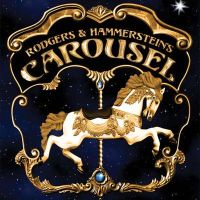
Mouse Whisper
The taxi driver recounted the story of the famous Australian cricketer who promised $50,000 towards the reconstruction of the Galle cricket ground since it lay outside the fortress walls and was completely destroyed by the 2004 tsunami. The amount promised was modified several times and when we asked how much this cricketer eventually had actually given, the driver signalled with his fingers – zero.
A different type of gall I would think.
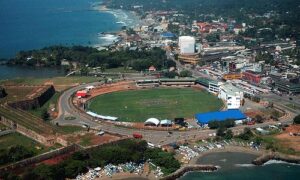

I should have observed that white asparagus is not all that rare per se as it is just asparagus never exposed to sunlight before picking, hence never turned green.
As for carrageenan I am outside my comfort zone although I do think everyone is aware that a number of foods including ice cream use seaweed based gelatine-like substance. More in keeping with your theme if only in name asparagopsis is recently getting agrimedia interest owing to its ability to turn off methane production in cattle. It is derived from a red seaweed, but one different from carrageenan.
The Australian asparagus season is short, barely extending from September to November as you know and you are right that most (96%) is grown in Victoria including in Kooweerup. White asparagus is rare as it is much more expensive to produce and process, as for example it must be peeled, usually done before retail sale. The market is not there for the higher prices this entails. But if you are in Melbourne in asparagus season it can usually be obtained from Prahran Market, although supply is limited and best pre-ordered from a quality stall holder.
Samphire has no particular season or constraint but is also in general spring fare. Preston Market is the place for that, along with beach bananas, aka pig face.